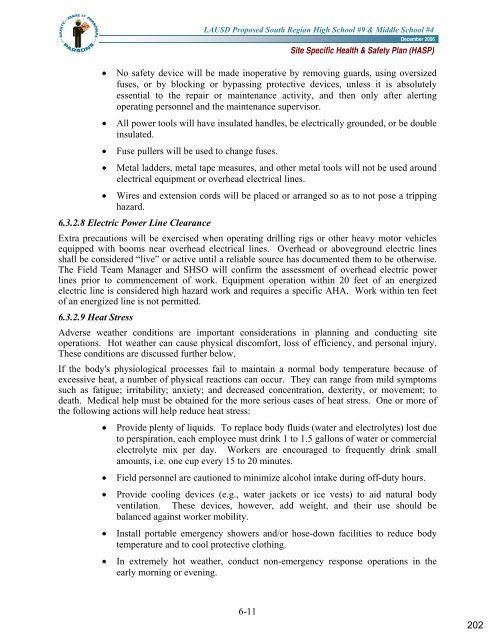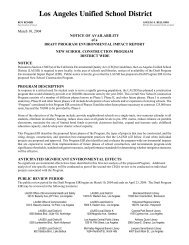Site-Specific Health and Safety Plan (HASP) - Laschools.org
Site-Specific Health and Safety Plan (HASP) - Laschools.org
Site-Specific Health and Safety Plan (HASP) - Laschools.org
You also want an ePaper? Increase the reach of your titles
YUMPU automatically turns print PDFs into web optimized ePapers that Google loves.
LAUSD Proposed South Region High School #9 & Middle School #4<br />
6-11<br />
December 2006<br />
<strong>Site</strong> <strong>Specific</strong> <strong>Health</strong> & <strong>Safety</strong> <strong>Plan</strong> (<strong>HASP</strong>)<br />
• No safety device will be made inoperative by removing guards, using oversized<br />
fuses, or by blocking or bypassing protective devices, unless it is absolutely<br />
essential to the repair or maintenance activity, <strong>and</strong> then only after alerting<br />
operating personnel <strong>and</strong> the maintenance supervisor.<br />
• All power tools will have insulated h<strong>and</strong>les, be electrically grounded, or be double<br />
insulated.<br />
• Fuse pullers will be used to change fuses.<br />
• Metal ladders, metal tape measures, <strong>and</strong> other metal tools will not be used around<br />
electrical equipment or overhead electrical lines.<br />
• Wires <strong>and</strong> extension cords will be placed or arranged so as to not pose a tripping<br />
hazard.<br />
6.3.2.8 Electric Power Line Clearance<br />
Extra precautions will be exercised when operating drilling rigs or other heavy motor vehicles<br />
equipped with booms near overhead electrical lines. Overhead or aboveground electric lines<br />
shall be considered “live” or active until a reliable source has documented them to be otherwise.<br />
The Field Team Manager <strong>and</strong> SHSO will confirm the assessment of overhead electric power<br />
lines prior to commencement of work. Equipment operation within 20 feet of an energized<br />
electric line is considered high hazard work <strong>and</strong> requires a specific AHA. Work within ten feet<br />
of an energized line is not permitted.<br />
6.3.2.9 Heat Stress<br />
Adverse weather conditions are important considerations in planning <strong>and</strong> conducting site<br />
operations. Hot weather can cause physical discomfort, loss of efficiency, <strong>and</strong> personal injury.<br />
These conditions are discussed further below.<br />
If the body's physiological processes fail to maintain a normal body temperature because of<br />
excessive heat, a number of physical reactions can occur. They can range from mild symptoms<br />
such as fatigue; irritability; anxiety; <strong>and</strong> decreased concentration, dexterity, or movement; to<br />
death. Medical help must be obtained for the more serious cases of heat stress. One or more of<br />
the following actions will help reduce heat stress:<br />
• Provide plenty of liquids. To replace body fluids (water <strong>and</strong> electrolytes) lost due<br />
to perspiration, each employee must drink 1 to 1.5 gallons of water or commercial<br />
electrolyte mix per day. Workers are encouraged to frequently drink small<br />
amounts, i.e. one cup every 15 to 20 minutes.<br />
• Field personnel are cautioned to minimize alcohol intake during off-duty hours.<br />
• Provide cooling devices (e.g., water jackets or ice vests) to aid natural body<br />
ventilation. These devices, however, add weight, <strong>and</strong> their use should be<br />
balanced against worker mobility.<br />
• Install portable emergency showers <strong>and</strong>/or hose-down facilities to reduce body<br />
temperature <strong>and</strong> to cool protective clothing.<br />
• In extremely hot weather, conduct non-emergency response operations in the<br />
early morning or evening.<br />
202







